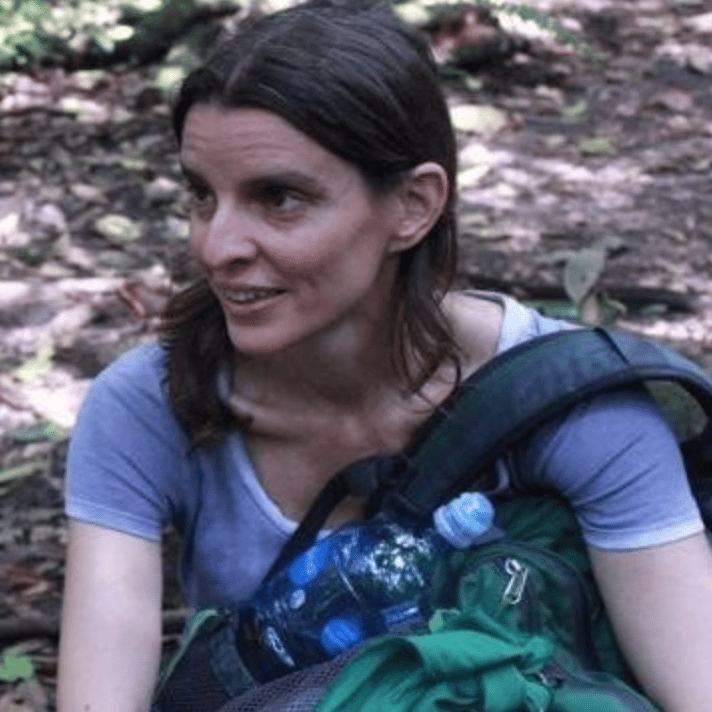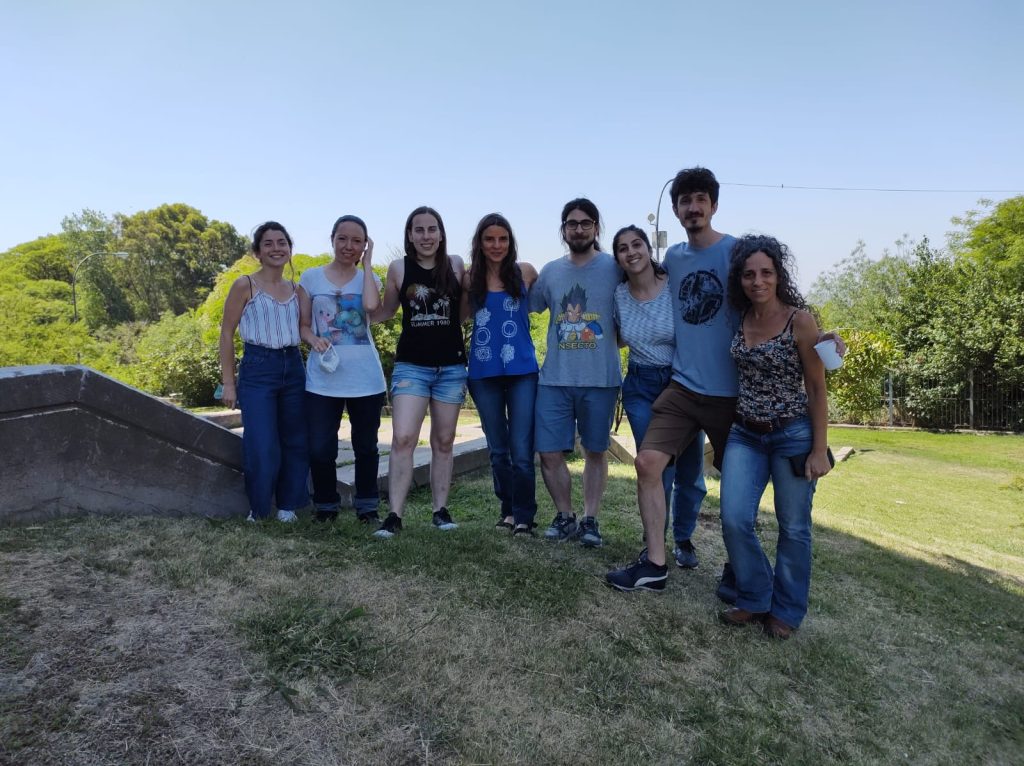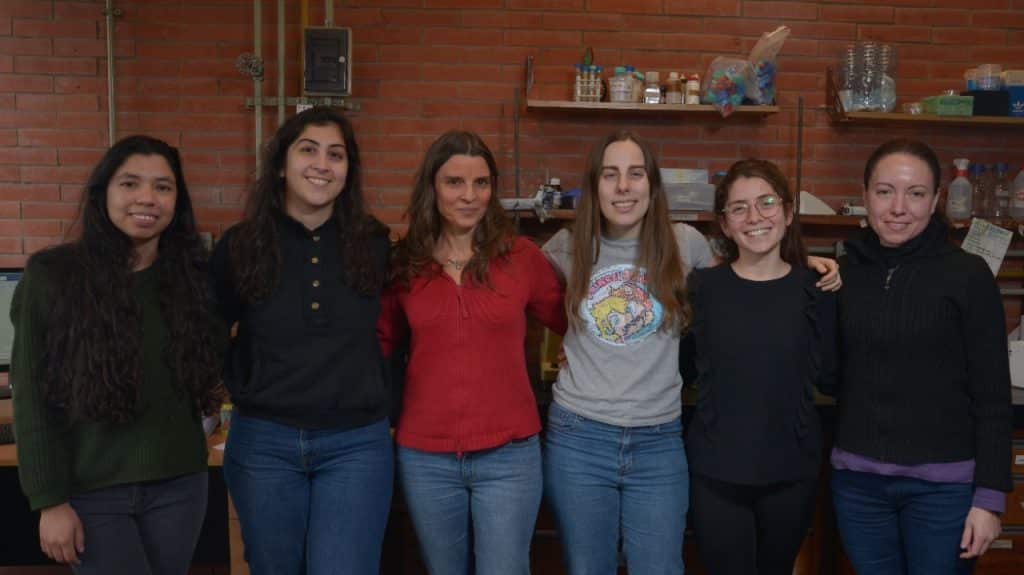An interview with Valeria Levi
Posted by Mariana De Niz, on 24 October 2022

MiniBio: Dr. Valeria Levi is an Associate Professor in the Faculty of Exact and Natural Sciences at CONICET. She is head of Intercellular Dynamics Lab. Valeria studied her BSc in Chemistry at the University of Buenos Aires in 1997, and completed her PhD in 2001. Between 2002 and 2006, she did her postdoc at the Laboratory for Fluorescence Dynamics at the University of Illinois, in the USA, where she specialised in advanced methods in fluorescence microscopy for biological systems. She has received several accolades for her work, including the Young Fluorescence Award from the Biophysical Society in 2008, and the L’Oreal-UNESCO award for women in science in 2017.
What inspired you to become a scientist?
My trajectory started like many scientists, with high doses of curiosity as a child; I was always trying to figure out how things worked. When I was a little girl, I used to pick up rocks to discover which bugs hid under the rock; for me, it was marvelous seeing this “little world” under the rock (very similar to the sensation I have now when I see cells under the microscope). Also, I loved the process of trying to find solutions to different problems- from puzzles to math exercises.
In high school, I had an excellent Chemistry teacher who showed me that science could be as fun as my puzzles and that the scientific method is an excellent way to solve problems. This teacher was fundamental to define my future career.
You have a career-long involvement in cell biology, stem cells, and microscopy. Can you tell us a bit about what inspired you to choose these paths?
My scientific trip started as an undergrad student (in Chemistry) when I learnt about fluorescence spectroscopy. I remember that the photon-emission process fascinated me from a molecular point of view and as a tool to detect what tiny little molecules were doing. For me, it felt like molecules were sending messages.
In parallel, I was also fascinated with molecular motors: their ability to produce nano-movements from chemical energy was absolutely awesome. Then, I learnt about single-molecule microscopy techniques that allowed observing the steps of these motors and it was completely clear for me that I wanted to learn microscopy and to study how biomolecules worked in their natural environment. Therefore, I moved abroad and worked at the Laboratory for Fluorescence Dynamics at the University of Illinois with Enrico Gratton, the most wonderful place to learn microscopy.
Can you tell us a bit about what you have found uniquely positive about becoming a researcher in Argentina, from your education years?
Argentina has a long-standing tradition of high-quality, public and free universities that persists along the years despite the fact that Argentina is not a rich country. We firmly believe that education is a human right and not a privilege.
This simple but powerful statement promotes a very stimulating environment for research, learning and teaching. Working in these three activities with relatively low amounts of money is also challenging and requires lots of ideas and imagination. I think that our graduates are experts on solving every problem with not too many resources.
Once you chose microscopy as a profession or main discipline, can you expand more about how your career has progressed in this line?
I think that, as is common for many low and middle income countries (LMICs), one’s professional development is not only related to one’s own abilities, but to the social context.
In my case I was able to return to my home country and got a position as a research scientist because the government at that moment considered science as a national priority, making an unprecedented investment in human resources and funding. Thanks to those actions, we were able to acquire a last-generation confocal microscope and setup a very small-scale facility. This opened the possibility to start working in fluorescence fluctuation methods, which I had learnt during my postdoc.
Single-molecule methods and other microscopy techniques are very powerful techniques that allow us to explore how several processes occur in living cells. Having started with the observation of molecular motors, I progressively became involved in collaborations with different groups working on transcription factors. Moving to living embryos and stem cells was just a simple step forward. We could use these technologies to study how a cell changes its transcriptional program and defines a different cell fate.
Can you tell us a bit about your day-to-day work as a researcher involved in microscopy?
I think that, as many researchers, we spend a lot of time doing things that are not directly related with research. However, I am very proud that one of my dreams became true in these years: we founded the “Gregorio Weber Fluorescence Microscopy Facility” at my University (Universidad de Buenos Aires) which has state of the art microscopes, well-prepared technicians, and it is open to the community.
Now, I spend most of my productive time with my PhD students, helping them thinking, analyzing experiments and interpreting data. As other researchers of my age and position, I spend less time at the microscope and more time at the computer!

Did you have many opportunities to interact with other Latin American groups, outside of Argentina?
Yes, of course! I believe that science is a collective process that requires collaborative work with other people not only in Latin America. The pandemic and the economic situation in Argentina limited our possibilities of travelling abroad but I believe that we are slowly returning to the necessary face-to-face contact. Also, my postdoctoral stay at the Laboratory of Fluorescence Dynamics offered me an incredible opportunity to meet and make friends from Latin America, and we eventually managed to organize several editions of Microscopy Workshops in Chile, Brazil and Argentina.
Have you ever faced any specific challenges as an Argentinian researcher, working abroad?
No, just some ignorance about Argentina and its education and science.
Who are your scientific role models (both Argentinian and foreign)?
I have many scientific models, but I must mention Enrico Gratton in the top position. He is like my scientific father; he transmits passion and love for science. I really enjoyed working with him because it was like playing, but instead of using toys, we used ideas and microscopes. Enrico is also a model for his intelligence, generosity and creativity.

What is your opinion on gender balance in Argentina, given current initiatives in the country to address this important issue. How has this impacted your career?
The situation in Argentina is very similar to what happens in many countries: for example, when you analyze the life sciences field, there is gender balance in undergrad and PhD students but as you climb in the hierarchical pyramid there are fewer women in decision-making positions. It is even more difficult in other disciplines in which the inequality is present well before girls enter University.
Being a woman in this man-shaped scientific world is very difficult; I think that I started to be aware of that after I returned to Argentina. We have been taught that success in science is purely meritocratic although it is completely demonstrated that many social factors (including the fact that women are usually more involved in domestic and child care duties) affect our careers.
The other problem associated to gender inequality is that many great ideas (those coming from women or minorities) are neither discussed nor included in the “scientific agenda”; this is a terrible loss for science; we are losing ideas simply because we are discriminating people due to their gender.
This is why we still need affirmative actions to include women in top positions and we need to work to facilitate the scientific track of young (women) researchers.
What is your favourite type of microscopy and why?
Fluorescence, of course!
What is the most extraordinary thing you have seen by microscopy? An eureka moment for you?
I would say that the most beautiful thing are organelles transported by molecular motors along microtubules. When you think of a biological process, you know the theory, you think in molecules and thermal noise. But observing the live-action, that something moves continuously and directionally along a track as if it had nano-legs is something incredible.
What is an important piece of advice you would give to future Argentinian scientists? and especially those specializing as microscopists?
I would recommend them to do a postdoc abroad and then return to Argentina to teach what you have learnt. It is an awesome experience working in a completely different environment with more economical resources, last-generation microscopes, and the possibility of collaborating with incredible researchers in the area. It is also very interesting from a cultural and social point of view working side-by-side with people from different places of the world.
Where do you see the future of science and microscopy heading over the next decade in Argentina, and how do you hope to be part of this future?
This is a very difficult question! I can answer which areas of microscopy we should develop in my country.
I think we need to move further to high-throughput imaging which is changing the way we explore cell processes. This technology is not extended in Argentina. I believe that we will also see a growing number of new (faster and simpler) superresolution methods and a consequent increase of their applications to answer questions in the field of life sciences.
Beyond science, what do you think makes Argentina a special place to visit and go to as a scientist?
I love Argentina and that’s the reason I returned from my 3-year postdoctoral stay at Urbana-Champaign. Although it can be hard and difficult to accomplish a normal scientific career sometimes, I am very proud of my origins and committed to ‘pay back’ all the education that I received. We have a long-standing tradition of excellent public universities and research centers and I feel that it is our duty to guarantee equal opportunities for all. Having an experience abroad it is a must for assuring high quality science and establishing working networks. When I think of what we were able to achieve with so little resources it is incredible. I believe that we have generated a great scientific community in Argentina, open to collaborate with international partners. In addition, our country is an excellent destination for tourism! Not only do we have a wide variety of landscapes, but also several cultural heritages that make it a very special place to visit in the southern hemisphere.


 (No Ratings Yet)
(No Ratings Yet)